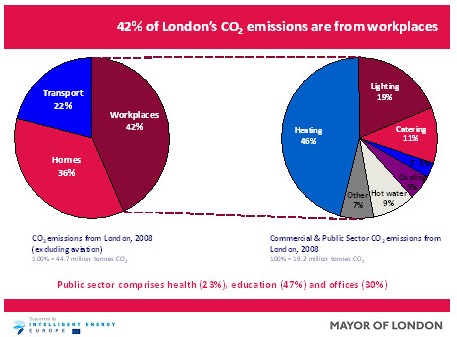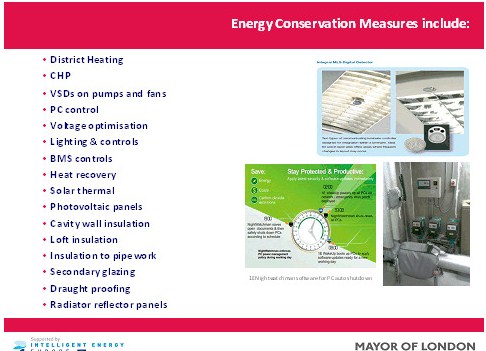
Boris Johnson, the Mayor of London, has made a commitment to making London a world-leading low carbon capital city by 2025 with an ambitious target of cutting the city’s carbon emissions by 60 percent over the intervening period. The policy is set out in the Mayor’s Climate Change Mitigation and Energy Strategy and improvements in performance of existing public buildings in London are a particular concern given that they contribute as much as 10 percent to the city’s carbon footprint.
Improving the energy efficiency of public buildings is therefore vital in the attempt to reduce London’s CO2 emissions. Furthermore, recessionary considerations means that the existing buildings most responsible cannot simply be replaced on mass and therefore they have to work harder to achieve efficiency improvements. RE:FIT is an programme that has been established to help the city achieve this objective.
REM talks to Robert McKinnon of Turner & Townsend to find out more.
What is REFIT?
The Greater London Authority (GLA) has established RE:FIT, a building retrofitting scheme to support public sector organisations to reduce their carbon footprint and energy bills.
The RE:FIT Framework, available to all public sector organisations in the UK, streamlines the procurement process for energy efficiency works by providing pre-negotiated, EU-regulation-compliant contracts that can be procured from a group of 13 pre-qualified specialist Energy Service Companies (ESCos).
The ESCo assesses, designs and installs Energy Conservation Measures (ECMs), rectifying backlog maintenance and increasing the facilities reliability; cutting running costs, saving significant amounts of energy and reduce carbon emissions. Crucially, the RE:FIT ESCo guarantees the level of energy savings, thus offering a secure financial saving over the period of the agreement.
The RE:FIT programme can be used for a broad range of measures to save energy, including simple and more complex technologies, from insulation and building fabric improvements, replacement or upgrading of mechanical and electrical services and the installation of bespoke energy efficiency measures such as combined heat and power (CHP) and voltage optimisation equipment. Renewable technologies are also possible where appropriate.
Helping RE:FIT to succeed is the Programme Delivery Unit (PDU), operated by Turner & Townsend since September 2011. The Programme Delivery Unit provides support through benchmarking information, recommending optimum financial and CO2 savings, and helping public sector organisations through the procurement, implementation and verification project phases.
The Programme Delivery Unit’s support is fully funded by the GLA and the ELENA programme (European Local Energy Assistance), so the service is at no cost to London’s public sector organisations.
What kind of organisations is it designed to support?
RE:FIT and the Programme Delivery Unit has been designed to support public sector organisations to reduce their carbon footprint and energy bills.
It helps organisations who are publically funded and can support, councils, the NHS, government departments, Schools, FE Colleges, Universities and the Heritage and Culture sector such as museums.
Can you cite any particularly interesting examples or case studies?
There are a variety of examples, including:
Goldsmiths, University of London
Ealing, Harrow and Enfield Councils
Transport for London and the London Fire Brigade
Royal Botanic Gardens, Kew
Newham University Hospital
How big is the need to improve energy performance in commercial and public buildings? Are companies now starting to really take notice of this issue?
Energy Performance Contracting is growing the UK and companies are recognising the benefits of such an arrangement as the risk is being transferred from the organisation to the Energy Service Company (ESCO). The RE:FIT Framework provides the legal support and compliant surround to enable public sector organisations to take a more holistic approach to their energy reduction across their estates.
Organisations are recognising the challenges of increasing energy prices, reducing budgets, CRC charges and also the impact of maintenance laggard - particularly with their existing M&E equipment. Programmes such as RE:FIT, also provide the opportunity to improve existing working environments and equipment.
What is an Energy Service Company (ESCo) and do you use one in particular for London or are there several?
The RE:FIT Framework comprises 13 ESCos, all of whom are leading specialists in this field. These suppliers have been through a full OJEU process and the RE:FIT programme provides the structure, documents and technical specialists to support public sector organisations to carry out the mini competition to select a preferred supplier, and then to develop the detailed Investment Grade Proposal.
Importantly with RE:FIT the proposed savings identified at mini-competition are guaranteed by the successful ESCo supplier, as a minimum.
What are the carbon reduction targets for London’s public buildings?
There is ambitious target by 2025 of cutting the city’s carbon emissions by 60 percent over the intervening period. RE:FIT is one of several Mayoral schemes that is helping to reduce the capital’s emissions and it is already saving over £2.1m per annum in energy costs and an estimated CO2 reduction of 13,000 tonnes per annum, (involving 136 public sector buildings.) The pipeline includes further retrofitting works in 410 public sector buildings, with c.£75m of capital investment and growing.

What are the main measures and technologies that are being installed by REFIT?
An example of the range of technologies being used are shown below, but the list is not exhaustive.
Also the PDU will work with public sector organisation and the ESCO to develop the best range of measures to realise optimal efficiencies.

How is the scheme funded?
The RE:FIT Framework recognises that different public sector organisations may require different approaches to fund energy efficiency projects and as such has been designed to be flexible when it comes to finance options. A wide range of finance approaches can be used to determine the most optimal finance solution for each RE:FIT project, all in an open book manner and regulated under the REF:FIT framework. These can include:
The chosen overall financing solution may include a mix of different approaches above to cover different elements of the project. For example, some aspects may be directly funded by the council, some through borrowing and the remaining elements funded through the Energy Service Company, via Salix, or a third party, the final mix blended in an open book and regulated manner.
Further information:

